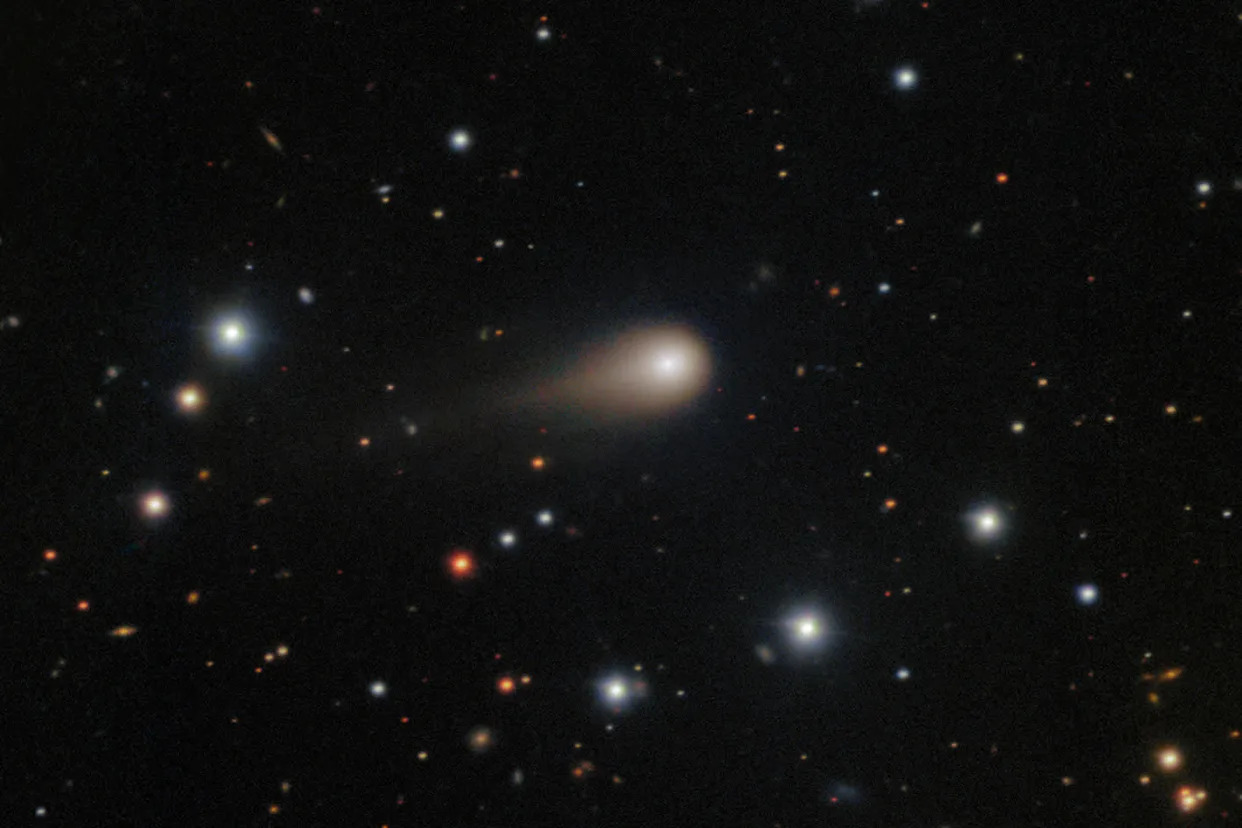Science
Interstellar Comet 3I/ATLAS Approaches Closest Point to the Sun

An interstellar comet, designated as 3I/ATLAS, is set to reach its closest approach to the sun on October 30, 2025. This remarkable celestial body, which has drawn significant attention from astronomers worldwide, poses no threat to Earth as it will not come closer than 170 million miles from our planet.
Discovered on July 1, 2025, by the NASA-funded Asteroid Terrestrial-impact Last Alert System (ATLAS) survey telescope in Rio Hurtado, Chile, Comet 3I/ATLAS is the third known interstellar object observed passing through our solar system, following 1I/’Oumuamua in 2017 and 2I/Borisov in 2019. Astronomers have traced its visibility back to June 14, thanks to extensive archival data.
Characteristics and Composition of 3I/ATLAS
The comet’s nucleus measures between 1,444 feet and 3.5 miles in diameter. Observations from the Hubble Telescope have revealed that it is composed primarily of ice, surrounded by a bright cloud of gas and dust known as the coma. This vaporization of ice and dust as the comet approaches the sun is what gives it a fuzzy appearance and potentially a tail.
Astronomers believe that 3I/ATLAS may have formed billions of years ago, suggesting it could be older than the solar system itself. Its classification as a comet stems from its icy composition and the presence of the coma.
The comet’s trajectory is classified as hyperbolic, indicating that it is not following a conventional orbital path around the sun. Traveling at approximately 137,000 miles per hour, it is moving too quickly to be captured by the sun’s gravitational pull.
Scientific Significance and Future Observations
Despite its rapid journey through the solar system, 3I/ATLAS presents a unique opportunity for scientific research. Interstellar objects like this one serve as cosmic time capsules, potentially containing valuable information about other star systems formed billions of years ago.
Early observations have revealed unexpected atomic nickel vapor emanating from the comet, detected at a significant distance from the sun, where temperatures are exceedingly cold—about four times the distance of Earth from the sun. Such conditions typically prevent solid metals like nickel from vaporizing, prompting scientists to explore alternative explanations. They speculate that the nickel may be interacting with carbon monoxide or other organic compounds, allowing it to release nickel atoms at much lower temperatures.
As 3I/ATLAS approaches its nearest point to the sun, it will pass just inside the orbit of Mars. By early December, it is expected to reappear on the opposite side of the sun, but visibility will be limited without a telescope. The scientific community remains eager to learn more about this extraordinary comet and the insights it may provide into the formation and evolution of celestial bodies outside our solar system.
-

 Sports2 weeks ago
Sports2 weeks agoSteve Kerr Supports Jonathan Kuminga After Ejection in Preseason Game
-

 Politics2 weeks ago
Politics2 weeks agoDallin H. Oaks Assumes Leadership of Latter-day Saints Church
-

 Science2 weeks ago
Science2 weeks agoChicago’s Viral ‘Rat Hole’ Likely Created by Squirrel, Study Reveals
-

 Lifestyle2 weeks ago
Lifestyle2 weeks agoKelsea Ballerini Launches ‘Burn the Baggage’ Candle with Ranger Station
-

 Lifestyle2 weeks ago
Lifestyle2 weeks agoDua Lipa Celebrates Passing GCSE Spanish During World Tour
-

 Entertainment2 weeks ago
Entertainment2 weeks agoZoe Saldana Advocates for James Cameron’s Avatar Documentary
-

 Business2 weeks ago
Business2 weeks agoTyler Technologies Set to Reveal Q3 2025 Earnings on October 22
-

 Business2 weeks ago
Business2 weeks agoMLB Qualifying Offer Jumps to $22.02 Million for 2024
-

 Health2 weeks ago
Health2 weeks agoRichard Feldman Urges Ban on Menthol in Cigarettes and Vapes
-

 World2 weeks ago
World2 weeks agoD’Angelo, Iconic R&B Singer, Dies at 51 After Cancer Battle
-

 Sports2 weeks ago
Sports2 weeks agoPatriots Dominate Picks as Raiders Fall in Season Opener
-

 Health2 weeks ago
Health2 weeks agoCommunity Unites for Seventh Annual Mental Health Awareness Walk








